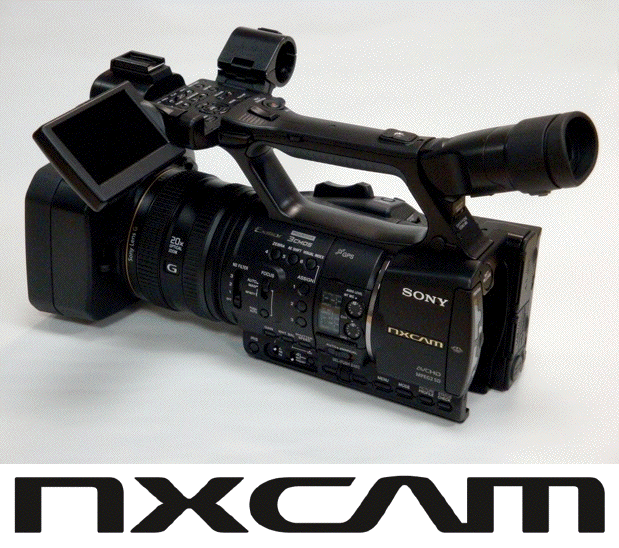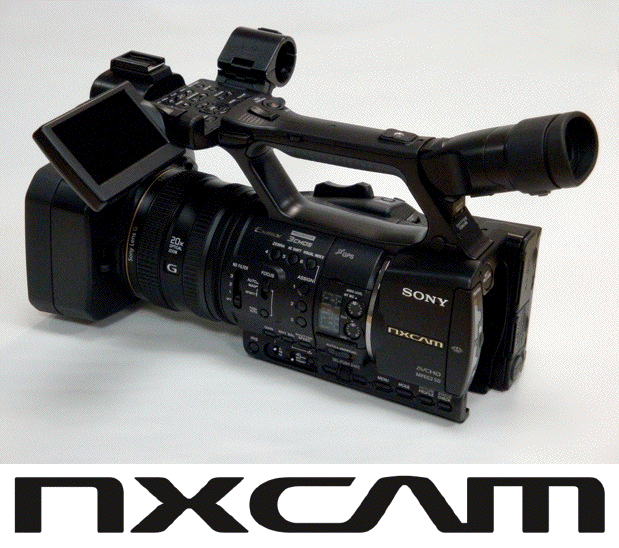
For the past few days, I’ve been evaluating a prototype of Sony’s first NXCAM camera family member. This first NXCAM model has a striking resemblance to a Sony Z5, which is an HDV tape-based camcorder with optional chip recording. Unlike the Z5 chip recording (which limits its HD recording with the exact same specs as the ones that the camera offers on HDV tape), this first NXCAM goes way beyond that, with much more flexibility in recording options, as you will learn in this article. You will see how this NXCAM model offers recording on two different types of solid state devices, offers selectable geo metadata recording with its built-in GPS, and even full compatibility with 10-bit 4:2:2 external recording with a device like AJA’s KiPro. You’ll also see other firsts in AVCHD camcorders, including timecode i/o and HD-SDI. Keep in mind that this is a first look at a prototype of Sony’s initial NXCAM offering.
New inboard video recording options
In HD mode, Sony’s NXCAM records H.264 in AVCHD format at a maximum bitrate of 24 megabit per second in best mode (“FX”). Fortunately, NXCAM offers full-raster 720p and full-raster 1080i/p (in addition to subsampled 1080 formats, and SD formats encoded with MPEG2). If you live the USA or other (ex-)NTSC country, this first NXCAM will start out (“off-the-shelf”) with the standard ±60Hz-derived formats:
- Full-raster 1080 (1920×1080) at 59.94i, 29.97p (truly native), or 23.976p (truly native)
- Subsampled 1080 (1440×1080) 59.94i
- Full-raster 720 (1280×720) at 59.94p
- Standard definition (720×480) at 59.94i
- Standard definition (720×480) at 29.97p recorded over 59.94i (not native)
- Standard definition (720×480) at 23.976p recorded over 59.94i (not native)
If you send a NXCAM to Sony for a WorldCam upgrade, it will also offer you:
- Full-raster 1080 (1920×1080) at 50i or 25p (truly native)
- Subsampled 1080 (1440×1080) 50i
- Full-raster 720 (1280×720) at 50p
- Standard definition (720×586) at 50i
- Standard definition (720×586) at 25p recorded over 50i (not native)
If you live in a 50Hz, (ex-)PAL location, simply reverse the two above lists to understand your “off-the-shelf” and after WordCam upgrade capabilities.
I welcome the native versions of the HD 23.976p, 25p, and 29.97p recordings. I know from personal experience with a client’s Panasonic AG-HMC150 that 720p29.97 is unfortunately recorded over 720p59.94 in that camera. In addition, according to Panasonic’s European spec sheet of the AG-HMC151 (which is the European version of the AG-HMC150), only 23.976p is recorded natively, which implies that 25p and 29.97p in that camera are unfortunately recorded over 50i and over 59.94i respectively. I am glad to see that Sony is offering the desired native modes for AVCHD. (If anyone knows of any firmware change from Panasonic to improve this, please comment below.)
New inboard audio recording options
According to Juan Martínez at Sony, NXCAM is the first AVCHD camcorder ever to offer the option of recording audio in linear PCM for higher quality, instead of the more common Dolby Digital. As many other Sony camcorders, NXCAM offers dual balanced XLR inputs which can be individually set for line, microphone, or microphone with 48-volt phantom power. The headphone output has a selector switch to choose among monitoring channel 1, channel 2, or a mix. There is also a menu setting to tell the camera whether the headphones are stereo or mono, which makes the switch work properly in each case.
NXCAM sensor and optics
The first NXCAM uses the same renowned 1/3″ EXMOR sensor and G lens as Sony’s Z5 camcorder. For details about the sensor and optics, see Adam Wilt’s review on that camera. NXCAM takes this image beyond the Z5 (which can only record sub-sampled 1080), since NXCAM can record full-raster 1080. When recording in 720p mode, NXCAM oversamples the video before recording (as the EX1 and EX3 also do in 720p). Also, NXCAM has a much improved image stabilizer.
Dual solid-state recording options
NXAM offers recording either to Sony’s Memory Stick PRO Duo, Memory Stick PRO-HD Duo, or a new NXCAM flash memory unit. I received the prototype with a 128GB version of this new NXCAM flash memory unit. This will be optional, and Sony has not yet set the price for it. NXCAM offers the option of creating identical or different types of recording on the NXCAM and on Memory Stick.
Output flexibility for monitoring and external 4:2:2 recordings
NXCAM offers both HDMI output and SD/HD-SDI output. When the camera is in live mode, the HD-SDI output is true 10-bit 4:2:2. Unlike some other cameras, which output a live HD-SDI signal at 10-bit which has been derived from an 8-bit signal, NXCAM (as the EX1 and EX3) output a true 10-bit signal over HD-SDI when live. The HD-SDI signal fortunately includes RP188 metadata, which means that a ideal recording can be made with a recorder like AJA’s KiPro (10-bit) or Convergent Design’s nanoFlash (currently 8-bit) with like timecode.
Multicam with matching timecode
Although this NXCAM model does not include genlock input, it does include a timecode i/o, which allows synchronizing the clock in multiple NXCAMs after making a temporary wired connection. Using the same connector, there is a switch to indicate whether it is being used as an input or an output.
Use NXCAM with a video mixer (“switcher”)?
As stated above, NXCAM does not include any genlock input. However, many recent HD video mixers (“switchers”) have a built-in frame synchronizer on their HD-SDI inputs, which means that NXCAM is a candidate! Some of these video mixers also include a built-in audio delay to compensate the video delay, which is a necessary evil in a frame synchronizer. (I’ll be covering some of those video mixers in upcoming articles.)
Wired remote control, i.e. mini-CCU
Although NXCAM includes a wireless remote control, for a multicam installation with a video mixer, a wired remote is much more appropriate. Fortunately, NXCAM is compatible with Sony’s RM-1000BP. In addition to zoom and record start/stop, the RM-1000BP allows access to iris, gain, and all of NXCAM’s menu adjustments. Third parties offer very long LANC cables, which will work to extend the RM-1000BP to wherever the video mixer is located, to facilitate matching cameras. Check out Adam Wilt’s review on the RM-1000BP here.
GPS
NXCAM includes a built-in GPS, which adds geo metadata to its video recordings. This information is already available in applications like Apple’s iPhoto ’09. I imagine that it will probably be in iMovie ’10 soon.
More details
For now, Sony is not releasing exact model number information or pricing. More details about that should be available in January. In the meantime, I will be publishing more articles about AVCHD workflow with different NLEs in the coming weeks.
Disclosure, to comply with the FTC’s new rules
Sony is not paying Allan T©pper to write this article, nor is Sony giving Allan T©pper a free NXCAM in exchange for this review. Allan T©pper must return the NXCAM prototype unit to Sony.
Allan T©pper’s articles and seminars
Get a full index of Allan T©pper’s articles and upcoming seminars at AllanTepper.com. Listen to his podcast TecnoTur, together with Tanya Castañeda, Rub©n Abruña, and Liliana Marín, free via iTunes or at TecnoTur.us.


